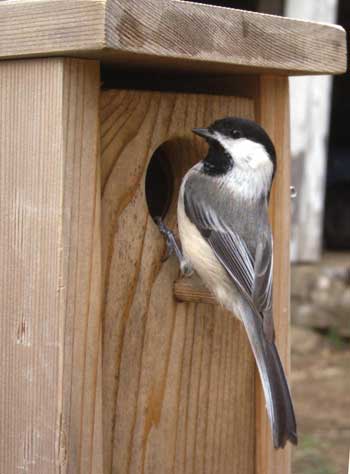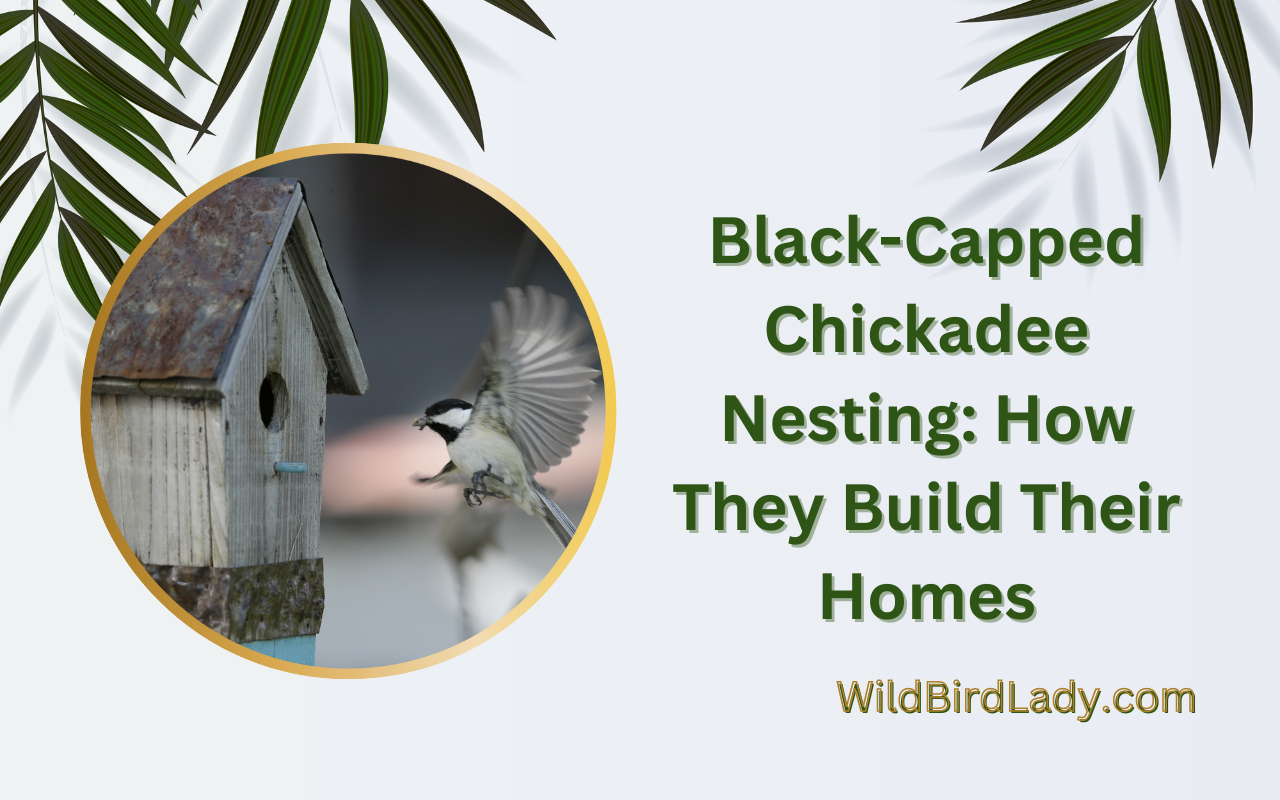The black-capped chickadee builds its homes in tree cavities and nest boxes, using moss, lichens, and grasses to create a soft bed for its eggs. These birds are known for their unique nesting habits, which involve excavating their own cavities or using existing ones.
Black-capped chickadees are found in northern north america, and their nests can be identified by their small size, round shape, and small entrance hole. These birds lay their eggs and rear their young in the nest, which they line with soft materials for warmth and comfort.
Black-capped chickadees are known for their distinctive calls and can often be seen flitting through the forest in search of food.

Credit: www.sialis.org
The Habitat Of Black-Capped Chickadee
Black-Capped Chickadee Nesting: How They Build Their Homes
When we think of bird nests, the first thing that comes to mind are those intricately woven baskets made of twigs. But did you know that some birds use cavities as their nesting sites? One such bird is the black-capped chickadee.
In this blog post, we will delve deeper into the nesting habits of these fascinating birds, with a focus on their habitats.
Description Of Black-Capped Chickadee Habitat
The black-capped chickadee is a non-migratory bird and can be found in different habitats such as deciduous and coniferous forests, woodlands, and parks across north america. These tiny birds have a distinct preference for mature, fragmented forests that have a mix of trees and open areas and are abundant in insects.
Let’s take a closer look at the specific features of their habitats.
- Habitat range: Black-capped chickadees can be found in a wide range of habitats across north america.
- Mixed forest: As mentioned earlier, chickadees prefer forested areas with a mix of deciduous and coniferous trees. They like open areas that allow light to filter through the canopy.
- Foraging requirements: Chickadees require a habitat that provides an abundant supply of insects and spiders to feed on.
- Tree cavities: They require tree cavities to nest in. However, they do not excavate their nest holes and rely on dead or decaying trees with existing cavities.
- Nesting territory: Once they find a suitable habitat with an ample food supply and nesting opportunities, they defend it aggressively against competitors.
The Importance Of Habitat In Building Nests
Black-capped chickadees are cavity nesters, which means they require suitable cavities to raise their young. The availability of cavities is a limiting factor in their survival and affects their breeding success. The selection of the right habitat can increase their chances of survival.
Here’s how:
- Suitable nest holes: Chickadees nest in tree cavities that are just the right size for them. Habitat with an abundance of suitable cavities improves their breeding success.
- Predation: Chickadees are preyed upon by larger birds such as hawks and owls. Mature forests with dense canopies provide better protection against predators than young or fragmented forests.
- Food availability: Chickadees require a diet rich in protein-rich insects to sustain their breeding season. These insects thrive in mature forests with a mix of deciduous and coniferous trees.
- Nest site competition: Chickadees are known to aggressively defend their nests against competitors. A suitable habitat with a low density of other chickadees or cavity nesters, in general, reduces competition for nest sites.
Black-capped chickadees require suitable habitats to survive and breed successfully. Their survival is tied to habitat conservation, and the preservation of mature and fragmented forests that provide the right conditions for these tiny birds is crucial. By understanding their nesting requirements and habitat preferences, we can take steps to protect these amazing birds and their homes.
Nesting Materials Used By Black-Capped Chickadee
Black-capped chickadees are adorable little birds that are common throughout much of the united states and canada. They are known for their cute appearance and their cheerful call, which sounds like “chick-a-dee-dee-dee”. But did you know that these birds are also skilled architects who build their own homes each year?
In this blog post, we will explore the nesting materials used by black-capped chickadees.
Common Materials Used By Black-Capped Chickadee To Build Nests
Black-capped chickadees are small birds, so they need to be creative when it comes to building their nests. They commonly build their nests in tree cavities, birdhouses, and even abandoned cars and buildings. Here are some of the materials that they use to build these nests:
- Moss
- Bark
- Grass
- Feathers
- Hair
- Spider webs
- Plant fibers
- Animal fur
Importance Of Specific Materials Used In Building Nests
Each of the materials used by black-capped chickadees serves a specific purpose in building their nests. Here’s a breakdown of the importance of some of the most commonly used materials:
- Moss: This material is used to line the inside of the nest. It helps to insulate the eggs and keep them warm.
- Bark: Chickadees use small pieces of bark to create a sturdy base for the nest.
- Feathers: Feathers are used to line the outside of the nest. They help to repel water and keep the eggs dry in wet weather.
- Spider webs: Chickadees use spider webs to hold the nest together. Spider webs are strong and durable, making them a good choice for this purpose.
- Animal fur: Chickadees use animal fur to create a soft and cozy lining for the eggs. This material helps to keep the eggs warm and comfortable.
Chickadees are resourceful creatures that use a variety of materials to build their nests. By using a combination of moss, bark, feathers, spider webs, and animal fur, these birds are able to create secure and comfortable homes for their young.
Black-Capped Chickadee Nesting Behavior
Black-capped chickadees are small birds that belong to the tit family. They are charming little creatures known for their acrobatic skills and cheerful nature. One of the most exciting aspects of these birds is their unique nesting behavior. In this section, we’ll explore the nesting habits and practices of black-capped chickadees.
Let’s dive in!
Overview Of Black-Capped Chickadee Nesting Behavior
Black-capped chickadee nesting behavior is unique and fascinating. Here are the key points:
- Black-capped chickadees are cavity nesters, which means they prefer to build their nests inside natural cavities or abandoned woodpecker holes.
- They also use man-made nest boxes.
- Male chickadees choose the nesting site and begin building the nest before the female arrives.
- The female then inspects the site and either accepts or rejects it.
- Black-capped chickadees have a high level of nest fidelity. They often use the same nesting site year after year.
- Nest building usually occurs in the early spring, and the female lays her eggs about two weeks after the nest is completed.
Nesting Habits And Practices Of Black-Capped Chickadee
Black-capped chickadees have specific nesting practices that ensure their young are kept safe and secure. Here are some key points:
- Black-capped chickadees construct their nests using various materials, including moss, grass, fur, and feathers. They bind the material together using spider webs.
- The nest structure is a cup-like shape with a small entrance hole.
- The female lays an average of 6-8 tiny eggs, which she incubates for around two weeks.
- Both the male and female chickadees take turns incubating the eggs.
- Once the eggs hatch, both parents work tirelessly to gather food for their young.
- Black-capped chickadees have been known to raise up to 3 broods in a single season!
Black-capped chickadees are extraordinary birds with unique nesting behavior. They are fascinating creatures to watch, and their nesting habits are impressive. By understanding their nesting practices, we can appreciate these tiny birds’ dedication to raising their young and creating a safe home.
The Nest-Building Process Of Black-Capped Chickadee
Black-Capped Chickadee Nesting: How They Build Their Homes
Black-capped chickadees are small birds that we often hear before we can see them. These birds are also well known to make their nests in the cavity of trees. We will look into the nest-building process of black-capped chickadee, including the factors that affect its outcome.
Detailed Explanation Of The Nest-Building Process
Black-capped chickadees start their nest-building as soon as early april. The process of nest-building takes around two weeks. The important steps in this process are:
- Chickadees select a suitable cavity or birdhouse to build their nest. They prefer the open woods, aspens, and shrublands where it’s easier to find food.
- They then start gathering nesting materials such as moss, fur, hair, and feathers. The chickadees need to gather enough material to make a soft lining.
- The birds use their beaks to construct a cup-shaped nest. They start with a foundation of moss and twigs and then add grass, leaves, and bark to create the desired shape.
- Once they have the shape, they start lining the nest with the soft materials they collected.
- Finally, they add feathers to the top of the nest, which serves as insulation and helps with temperature regulation.
Factors That Affect The Outcome Of The Nest-Building Process
The nest-building process may have different outcomes depending on the environmental factors at play. Some factors that may affect the outcome of the nest-building process are:
- Predators: If a cavity or birdhouse has easy access for predators, it may result in an unsuccessful nesting attempt.
- Availability of nesting materials: A lack of nesting materials nearby can force chickadees to build an unsuitable nest.
- Weather conditions: Extreme weather, such as wind and rain, may damage or destroy the nest.
- Pre-existing conditions of the selected cavity: If the cavity is too small or too large, then the nest may not be secure and chickadees may abandon the nest.
Black-capped chickadees take great care in building a comfortable and secure nest. To ensure a successful nesting attempt, it’s essential to provide a cavity or birdhouse with secure access, and sufficient nesting materials, and minimize the factors that may affect the outcome of the nest-building process.
Frequently Asked Questions On Black-Capped Chickadee Nesting: How They Build Their Homes
How Do Black-Capped Chickadees Choose A Nesting Site?
Black-capped chickadees prefer nesting sites that offer protection from the elements and predators such as trees with cavities, snags, and birdhouses. They also choose sites with plenty of food resources like insects and seeds.
How Do Black-Capped Chickadees Build Their Nests?
Black-capped chickadees build nests using moss, grasses, lichens, and bark fibers. They carve out a small nesting cavity inside the nesting cavity entrance, then line the nest with softer materials like feathers and animal hairs.
When Do Black-Capped Chickadees Build Their Nests?
Black-capped chickadees begin building their nests in late-april or early-may. Once the nest is complete, the female will lay between 6-8 eggs and incubate them for 12-13 days.
Conclusion
Chickadees are truly remarkable birds, with their cute looks, intelligent minds, and extraordinary nesting habits. They build their homes with meticulous attention to detail, using only the best materials and resources available. The black-capped chickadee, in particular, is known for its ability to carve out the perfect nesting cavity in the most unlikely of places.
These amazing birds are an inspiration to many, reminding us of the importance of hard work, perseverance, and creativity in achieving our goals. As we conclude our exploration of the black-capped chickadee’s nesting habits, we must remember to appreciate the beauty of nature and all the wonders it has to offer.
Let us continue to cherish and protect these amazing creatures and their habitats, so that future generations may also have the opportunity to witness their grace and charm.



